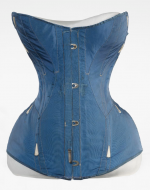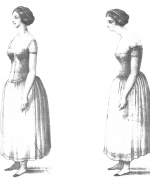Created by Hunter Wolf on Mon, 02/17/2025 - 16:47
Description:
Corset makers shaped Victorian fashion, yet their work is rarely visible as corsets are intended to be worn as undergarments beneath other layers of clothing. However, like so much else during the Victorian period, corsetry was revolutionized as the designs shifted to fit the body rather than the style of the time. Corsets are intended to provide support to a woman's back and breasts, but the garment achieves this function by modifying the torso. In my booth, I aimed to follow the trajectory of body-altering undergarments from stays (the precursor to corsets) to corsets designed both before and after the influence of Madame Caplin, a Victorian corset inventor, up until modern-day shapewear.
Booth on Corsets by Hunter Wolf, 2025. This 2D depiction of a booth on corsetry at the Great Exhibition of 1851 compiles shapewear from throughout the years, starting with stays from the 1700s and ending with a chest binder from 2016. It also includes two Victorian corsets, one of which was actually displayed at the Great Exhibition of 1851. The booth also depicts a framed image from the book Health and Beauty by Madame Roxey Ann Caplin, who displayed her work at the Great Exhibition.
Women's Stays, 1730-1740, from Wikipedia. Stays are the precursor to corsets. Whalebone was used to hold its shape, and unlike corsets they could be worn as undergarments or as an outer covering over a blouse. Stays first became popularized in the sixteenth century whereas corsets were most popular in the Victorian period. While they are similar to corsets in function, stays tend to be shorter and have tabs at the bottom hem whereas corsets are longer and have gussets to provide extra room for the bust in place of the tabs. Additionally, corsets were strictly a means of shaping the body and could not be worn as a bodice as stays could.
Blue Ribbed Silk Corset, 1851, from London Museum. This corset has a curved, hourglass shape. It fastens in the front and tightens in the back. This corset was put on display at the Great Exhibition by a staymaker named Madame Roxey Ann Caplin, who, along with her husband, is responsible for many improvements to the construction of stays and corsets. Madame Caplin referred to herself as an inventor rather than a dressmaker, and while she defended the merits of corsets to men who did not understand the significance of them, she also worked to make them more comfortable, lightweight, and modern.
2 Sketches of a Women Wearing Different Corsets, 1856, from Health and Beauty Chapter VI: On the Adaptation of the Corset to the Body, 1856, by Madame Roxey Ann Caplin. Madame Caplin defined herself not as a dressmaker, but as an inventor. She is credited with many changes to corset design, specifically changes that emphasize the natural shape of the body over fashion trends. These figures from Caplin's book Health and Beauty show Caplin's goal as an innovative corset maker. She claims in her book that the difference between herself and traditional staymakers is that she studied the human body and its natural shape whereas other staymakers studied fashion. The chapter of her book from which this image is taken is called "On the Adaptation of the Corset to the Body" because her focus is making the corset fit a person, rather than making a person fit a corset. This results in the straighter posture and happier expression on the left figure compared to the right.
Whalebone Cotton Corset, circa 1890, from "Undressed: A Brief History of Underwear," Exhibit at the Victoria and Albert Museum (April 2016-March 2017). This corset is longer than the previous one and has a straighter figure. Corsets in the Victorian Period were used to provide some support as well as modify the human body. Unlike Madame Caplin's corset, the whalebone embedded within this garment helps to hold its unnatural shape rather than emphasize a more natural body shape. One common purpose for corsets was to emphasize or hide the bosom (depending on the fashions of the time) and minimize the waist. The corset pictured likely served to hide the bosom, given the flatter top area of the corset and the fact that the garment is likely from the 1890s, a time in which pushing up the breasts had gone out of style.
Chest Binder, 2016, Nonbinary Wiki. Stays and corsets are both forms of shapewear: clothing that is intended to adjust the shape of the body. In the 2010s, the body positivity movement redefined shapewear as an industry to become more about supporting the body's natural state without altering it. Compression also became an important goal in shapewear, and it became more popular in athletics. Another use of compression shapewear that is commonly used today is chest binders. Chest binders compress the chest to make it appear flatter than it is. Binders are often used by members of the transgender community to boost confidence and affirm their gender.







